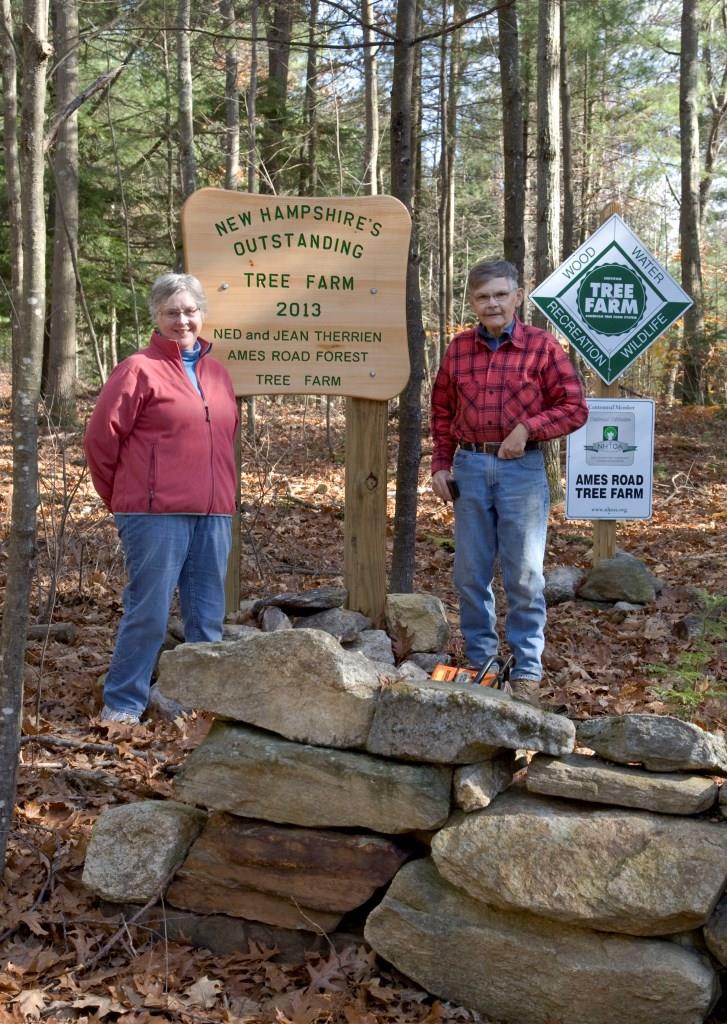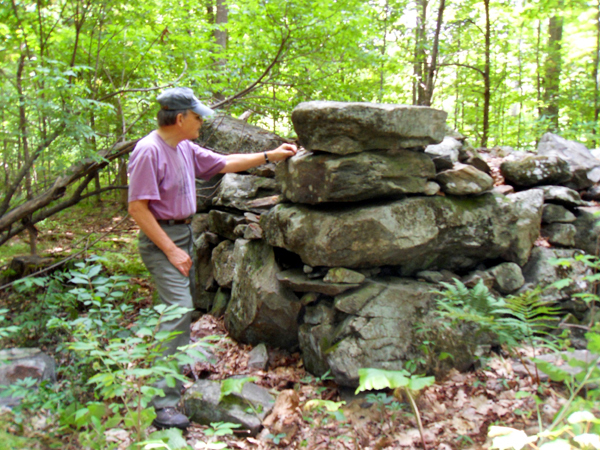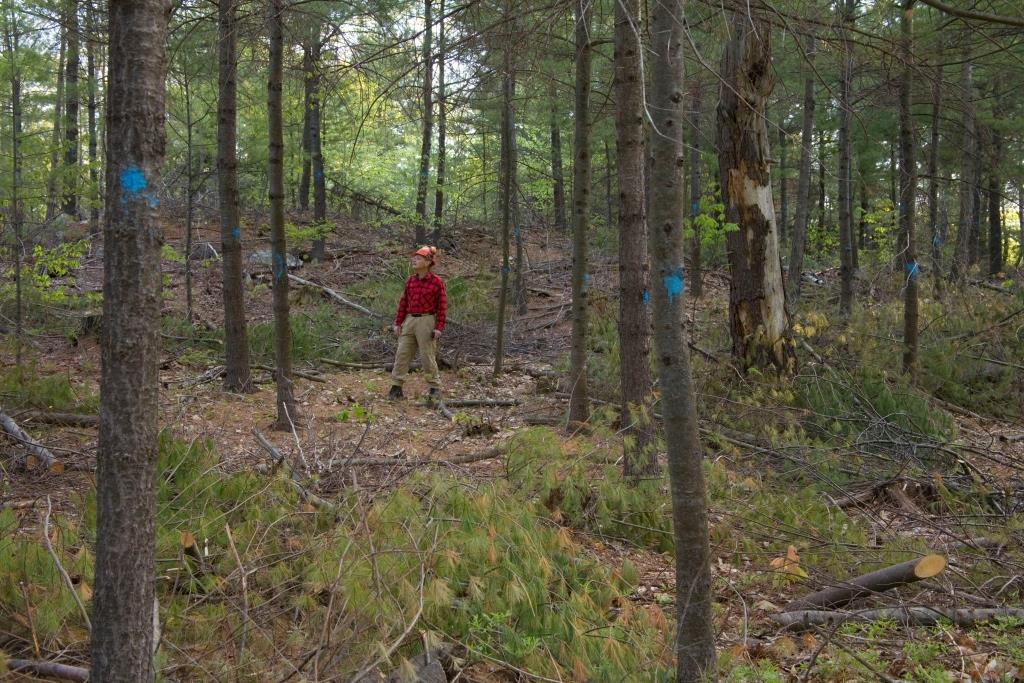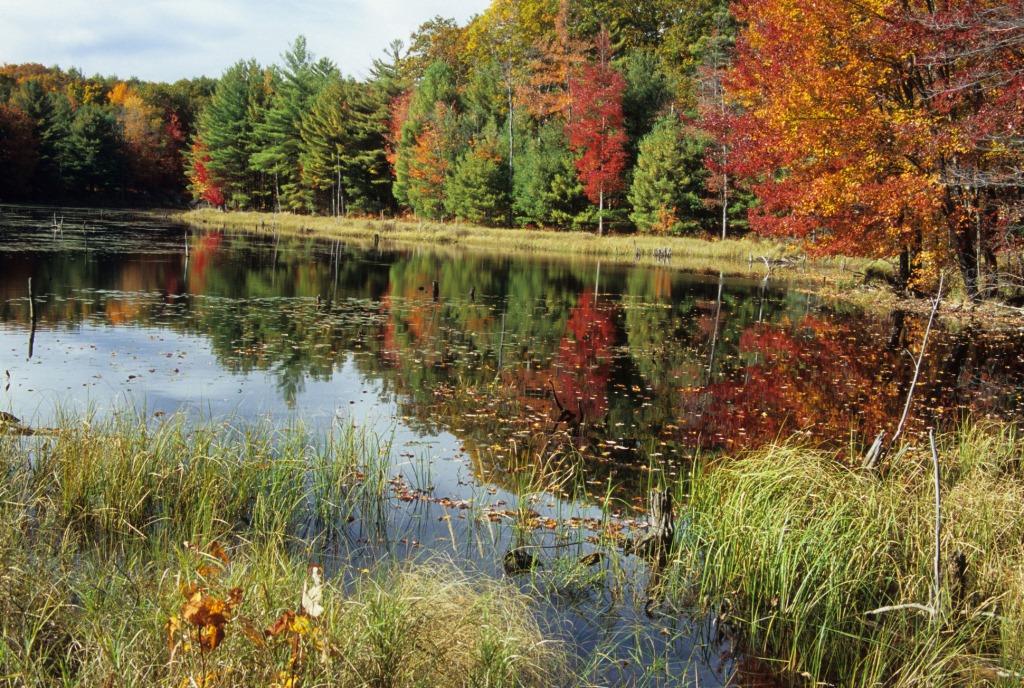Ned and Jean Therrien from New Hampshire
 What Makes Them Outstanding?
What Makes Them Outstanding?
Ned and Jean Therrien have done an exemplary job over the last 36 years managing their forestland for the multiple use concepts that the Tree Farm program promotes. Since the 119 acre property was purchased back in 1980, the Ames Road Forest has been managed carefully and thoughtfully. Ned maintains meticulous records showing management activities, financial return, and dollars spent on improvements. They have spent well over 13,000 hours improving the Ames Road Forest.
The Therriens actively manage their forest. Ned has a forestry degree and developed his own stewardship plan which he updates on a yearly basis. The silviculture and tree regeneration hereis impressive. Ned inventories the property every 10 years utilizing 58 permanent plots that areestablished throughout. The Therriens are devoted to Tree Farmís values of multiple use forestry. Numerous species of birds have been identified including 27 nesting species. Since 1980, Ned and Jean have raised 252 ducklings (Wood Ducks, Hooded Mergansers) in duck boxes. Vernal pools are identified and protected. Hiking trails throughout the property are actively maintained and open to the public. The property is also utilized on a regular basis for outdoor educational opportunities for a variety of organizations.
Ned has been active in the forestry community throughout his career and retirement promoting long term sustainable forestry and improving his own knowledge by attending workshops over the years. He has been a NH Tree Farm Committee landowner representative, president and board member of the NH Timberland Owners Association, guest lecturer for tree farm programs, and more.
The Therriens are committed to conserving Ames Road Forest as woodlands for perpetuity. They set a great example of how to responsibly manage forestland for multiple uses. They manage intensively, with great care and concern for how their activities will affect the future ofthe forest.
Tree Farmer Story
After years of searching for a small woodlot, we (Ned and Jean Therrien and our daughter, Kenna) found Ames Road Forest in 1978. It had been our dream to own forestland where we could practice forestry and produce income from our management efforts. We knew right away when walking across this property that this was the one. It had two large wetlands, a small brook, decent access, and a stand of young red oak and white pine that we could manage. It was beautiful. We had to borrow money to buy the parcel, but it was reasonably priced so our young family could fit the payments into our budget. The history of Ames Road Forest is typical of central New Hampshire woodlands settled in the late 1700s. The land had been burned, grazed and the best soils depleted of their fertility. In 1980, the forest we found was mostly hardwood and softwood pulpwood with scattered small sawtimber. American chestnut was common here prior to 1935. Old roads were reforested and stone walls were in disrepair, having been ignored for 180 years. The property has two large beaver ponds with an active beaver colony. Numerous birds, including wood ducks and geese, and other animals such as turtles, mink, otter, moose, deer, frogs, salamanders, insects, and other creatures use the ponds for resting and feeding.
Soils on the property are complex and full of stones, typical of New Hampshire hill country: the result of granite geology, glaciers, topography, and prior settlement. The highest elevation on the Forest is 895 feet, the lowest is 690 feet. A series of benches, separated by cliffs or short, steep hills, lead to the lower elevations. Shortly after acquiring Ames Road Forest, we walked the property with a soil scientist and dugtest holes, which gave us an overview of the soils and their potential to grow trees. Our objective was to return the forest soils and ground cover to a highly productive and healthy condition.
By 1981, working on weekends and holidays, we began management: identifying stands of trees, clearing road access, taking our first timber inventory, writing a basic management plan, and cleaning up trash and debris. I keep a daily diary of observations and work projects completed since the first day working here and use it to update the management plan annually. I indicate and map each project completed ineach stand. As of January 2014, we had spent more than 13,018 hours working at Ames Road Forest.
since the first day working here and use it to update the management plan annually. I indicate and map each project completed ineach stand. As of January 2014, we had spent more than 13,018 hours working at Ames Road Forest.
In the early years of ownership money was tight, so we began thinning trees with axes and hand saws. Slowly we worked up to a small chainsaw and a hard-used, four-wheel drive International truck. I marked the trees to cut, felled them, bucked each tree into 4-foot lengths and loaded the truck. In 1984, Ames Road Forest was certified as a Tree Farm. We were proud to erect the green and white sign at the entry to our property. During that summer, we contracted for our first commercial timber sale. I marked the trees to be cut and hired a logger with a cable skidder and a chainsaw. The logger cut 75,000 board feet of logs and 107 cords of pulp. Combined with the 50 cords of firewood that I had cut and sold during our first four years of management, our forest was beginning to show some promise. We were learning what it takes to be Tree Farmers.
After 33 years of intensive thinning and four commercial timber sales, we have an excellent forest of large red oak, white pine, and other hardwoods, totaling more than 18 cords of wood peracre. The makeup of our woodlands is white pine (40 percent), red oak (26 percent), red maple (14 percent), with hemlock, red pine, ash, black birch, sugar maple, and beech interspersed. By harvesting and thinning we eliminated most of the white birch and much of the American beech, and increased the mean diameter of our merchantable sawtimber to almost 13 inches. We have compensated for the average soils by increasing the intensity of forest management and getting good to excellent growth response from our trees. We constructed 2.7 miles of interior management roads, most of them grass covered with waterbars in appropriate locations. These roads give us access to all of our stands. Where our roadscome in contact with water, we use geotextile and stone to keep any soil from entering thewaterways.
In addition, we greatly improved the abandoned town road with stone surfacing to allow accessby logging trucks. We also have stopped erosion into Otter Pond from the road by constructing water bars, ditching, and installing a culvert and stone-lined soil catchments. This major effort will substantially improve the water quality. I have revised and expanded the initial management plan for Ames Road Forest several times into a detailed, site specific stewardship plan, which is certified by a licensed forester. In our planning and management efforts, we use the expertise of foresters, biologists, and other landowners.
When we completed the conservation easement on Ames Road Forest in 2013, we reached one of our goals to leave the property in better shape than when we acquired it.
In addition to forest management, Jean and I have hosted a number of events and led a number of tours: (2014 NH Tree Farm Field Day, two-day outdoor classroom for the local middle school, U.S Forest Service inspection team oversight tour.) Working together with the UNH Cooperative Extension and the NH Timberland Owners Association we hosted and led aWoodland Economics for Private Forestland Owners workshop. Owning a woodlot is our family business; the decisions we make have been family decisions. We have a large investment in time, sweat, and dollars in Ames Road Forest. Jean and I had to be totally invested in this effort to make it successful. When the time comes that we pass on, the new owner will receive a forest that has been substantially improved.
Wood
Using the best science-based forestry practices we know, we manage our timberland to provide a  regular income from timber harvests. To keep track of growth and harvest, we have 58 permanent plots located randomly through the 103 acres of timberland. I conduct a timber inventory at least every 10 years using an additional 50 plot locations to ensure accurate growth information by stand and species. The inventory is computerized. We do our own intensive timber stand improvement, which ensures an excellent rate of growth using both even-aged and uneven-aged management. Since 2008, Ned Therrien has intensively thinned more than 32 acres.
regular income from timber harvests. To keep track of growth and harvest, we have 58 permanent plots located randomly through the 103 acres of timberland. I conduct a timber inventory at least every 10 years using an additional 50 plot locations to ensure accurate growth information by stand and species. The inventory is computerized. We do our own intensive timber stand improvement, which ensures an excellent rate of growth using both even-aged and uneven-aged management. Since 2008, Ned Therrien has intensively thinned more than 32 acres.
Harvests are timed to ensure excellent returnon investment by following timber markets. We harvest trees that have reached their highest economic return. Ned Therrien marks the trees for harvest after consultation with a silvaculturist. Harvests are done through by contract with a certified master logger to ensure the best utilization and the least damage to the stands. Prescriptions call for leaving cavity trees on each acre and we have 1.7 cords per acre of standing live and dead cavity trees for wildlife. Currently, Ames Road Forest Tree Farm has more than 18 cords per acre of merchantable red oak, white pine, red maple and other species growing per acre.
Water
Ames Road Forest has two ponds (a total of 16 acres), 2,240 feet of permanent and intermittent streams, and five vernal pools. All of the shoreline is heavily vegetated. Domesticated livestock does not graze on the property. We protect water quality by preventing erosion from roads and skid trails. Where permanent roads are close to water we have used geotextile fabric covered with 3-inch crushed stone to harden the road surface. On hills that drain toward water, we usebest management practices including water bars, vegetated ditches, and stone catchments. In 2012, we enlisted a certified wetland scientist to examine our wetlands and develop a baseline to determine the health of the aquatic systems. The result is a report titled Wetland Functional Assessment, Ames Forest Wetland, Therrien Property, Ames Road, Canterbury, N.H.Timber harvesting in riparian areas on this property has several constraints including: no equipment within 50 feet of the shoreline (50-foot line to be identified by flagging); timber cannot be felled into any water body; and felled trees must be cabled or lifted out of the riparian zone
streams, and five vernal pools. All of the shoreline is heavily vegetated. Domesticated livestock does not graze on the property. We protect water quality by preventing erosion from roads and skid trails. Where permanent roads are close to water we have used geotextile fabric covered with 3-inch crushed stone to harden the road surface. On hills that drain toward water, we usebest management practices including water bars, vegetated ditches, and stone catchments. In 2012, we enlisted a certified wetland scientist to examine our wetlands and develop a baseline to determine the health of the aquatic systems. The result is a report titled Wetland Functional Assessment, Ames Forest Wetland, Therrien Property, Ames Road, Canterbury, N.H.Timber harvesting in riparian areas on this property has several constraints including: no equipment within 50 feet of the shoreline (50-foot line to be identified by flagging); timber cannot be felled into any water body; and felled trees must be cabled or lifted out of the riparian zone
Wildlife Including Threatened and Endangered Species
In 1984, we placed 12 duck boxes on trees on our 16 acres of ponds. Each winter we check the boxes for nesting activity. We clean and repair the boxes and replace the wood shavings. To determine the use of each box, we count egg cases and determine species by the thickness of the egg shells. Since 1984, 251 wood duck and hooded merganser chicks have fledged from the boxes we have installed on our ponds. Ten species of waterfowluse the two ponds for feeding and resting. We have identified 100 species of birds on the property; 30 of those nest at Ames Road Forest. We determine the number of existing cavity trees as part of the periodic timber inventory. We maintain a diversity of tree species to maintain wildlife diversity. Every few years, we mow the two landings and our roads to maintain them in grasses toprovide forage and nesting habitat for birds and mammals. Our wetlands are dammed by beaver. To provide hardwood trees for the beaver to feedon we have implemented thinning and harvests along the shorelines of the ponds. This ensures that we will continue to have beaver, ducks, and other wildlife on our ponds.
Recreation and Aesthetics Including Special Sites
Ames Road Forest is open to non-motorized recreation including hunting. Welcome signs and hunting permitted signs are posted at the two main entrances to the property. Our philosophy is that people are welcome to use the property as long as they treat the land with respect. We allow snowmobile use on the access road to the property. The road is part of a state of New Hampshire snowmobile trail network.The roads and trails on the property are mowed periodically so that walkers and crosscountry skiers can enjoy the land. At an overlook along one of our trails we have installed a Leopold Bench, designed by the wildlife biologist Aldo Leopold, for people to enjoy. We also have six interpretive signs along our trails to explain forest management and history of the property.


